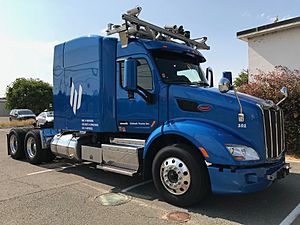Self-driving truck facts for kids
A self-driving truck, also called an autonomous truck or robo-truck, is a large vehicle that can drive itself without a human driver. These trucks use special technology to move goods and products on highways. Many companies are working on self-driving technology for different types of trucks, including big semi-trucks.
Some of the top companies developing these trucks include Waymo, Aurora, TuSimple, Gatik, and Kodiak Robotics. Experts believe self-driving trucks could be on highways in the United States by 2027.
Governments in the U.S. and Europe are creating new rules for these trucks. Some challenges include making sure they are safe, deciding if a human driver still needs to be inside, and creating clear laws for vehicles that drive themselves.
Contents
How Self-Driving Trucks Work
Self-driving trucks use many cool technologies to see the road, understand their surroundings, and make decisions. Think of it like giving the truck its own "eyes" and "brain."
Sensors: The Truck's Eyes and Ears
Sensors are super important for self-driving trucks. They help the truck "see" and "hear" what's happening around it.
- Lidar uses lasers to create a 3D map of the surroundings. It helps the truck see shapes and distances.
- Radar sends out radio waves to detect objects and measure how fast they are moving. It works well in bad weather.
- Cameras are like human eyes, capturing images and videos of the road, traffic signs, and other vehicles.
- Ultrasonic sensors use sound waves to detect nearby objects, especially when parking or moving slowly.
- GPS helps the truck know its exact location on a map.
These sensors work together to give the truck a full picture of its environment.
Mapping and Knowing Where You Are
Self-driving trucks use very detailed maps. These maps are much more precise than the ones you might use on your phone. They combine with real-time information from the truck's sensors. This helps the truck know exactly where it is on the road and what's coming up.
Some mapping techniques focus on highways, which is important for big trucks. This helps them handle challenges specific to long-haul driving.
Artificial Intelligence: The Truck's Brain
AI is like the brain of the self-driving truck. It helps the truck make smart decisions. Machine learning is a part of AI. It allows the truck to learn from its experiences and improve how it drives. For example, it can learn to make better choices about speeding up or braking.
Companies like PlusAI are developing systems that can predict potential dangers. This means the truck tries to guess if something risky might happen and takes steps to avoid accidents. AI also helps plan the best routes by looking at things like weather, traffic, and even where truck stops are.
While humans are still better at understanding complex situations, self-driving AI systems are getting much smarter very quickly.
These systems are the "muscles" of the truck. They control the steering, how fast the truck goes, and when it brakes. They also help the truck avoid obstacles and prevent crashes.
Just like self-driving cars, trucks use a mix of GPS and other sensors to figure out their position. This allows them to adjust their movements, turn, stop, and make decisions about how to drive safely.
The Future of Self-Driving Trucks
The trucking industry is very big, bringing in hundreds of billions of dollars each year. The market for self-driving trucks is also growing fast.
Jobs and Automation
Some people worry that self-driving trucks might mean fewer jobs for human truck drivers. However, many experts believe that the change to fully autonomous trucking will happen slowly. This is because of many factors, including new laws and how society accepts these new technologies.
Safety and Rules
Self-driving technology has the potential to make roads much safer. One study suggested that self-driving tech could have prevented more than half of deadly car crashes in the last ten years. This is important because thousands of people still die in crashes involving trucks each year.
Rules and Laws
In the United States, states like Nevada started making rules for self-driving vehicles, including trucks, back in the 2010s. By 2017, many states had created their own rules. The National Highway Traffic Safety Administration (NHTSA) also created federal guidelines for these vehicles. These guidelines help make sure self-driving cars and trucks are tested safely before they are used on public roads.
Some new laws, like one in California, still require a human driver to be inside all self-driving vehicles. This is partly for safety and partly to protect jobs. In Europe, they are also working on laws to allow fully self-driving trucks (where no human driver is needed inside). Germany was one of the first countries to create laws for fully automated cars and trucks.
Challenges for Self-Driving Trucks
Even with all the amazing technology, there are still some big challenges for self-driving trucks.
One challenge is figuring out who is responsible if a self-driving truck gets into a crash. If there's no human driver, who gets sued? Right now, if a regular truck crashes, people can sue the driver and the company. But with self-driving trucks, the manufacturers might not be legally responsible, which is a problem.
Another challenge is that many roads and cities are not designed for self-driving vehicles. We might need special lanes or parking areas just for them.
The biggest challenge is making sure these trucks are completely safe without a human driver inside. Many companies want to remove the safety driver to show the full power of autonomous vehicles. But until they can do that safely, it remains a big hurdle.
Finally, self-driving trucks are not yet perfect at handling sudden and unexpected changes in traffic. For example, if a freeway suddenly closes or there's a new crash, the trucks might struggle to react quickly and safely. While they can change lanes and merge, they aren't designed to interpret these very sudden and complex traffic situations yet.
See also



